

Processional Icon (1453)
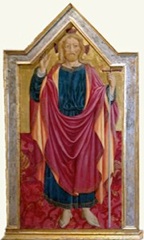
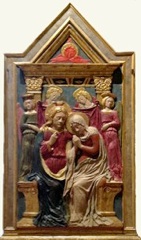
This wooden double-sided icon by Battista di Baldassare Mattioli was commissioned to replace an earlier one that was used in the annual procession from the Duomo to Santa Maria di Monteluce on the Feast of the Assumption of the Virgin. The procession was revived in 1999, using a reproduction of this original, which is now in the Museo Capitolare.
The icon depicts:
-
✴Christ the Redeemer on one side; and
-
✴the Coronation of the Virgin on the other.
Madonna and Child with angels (1465)
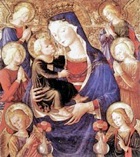
The panel depicts the half length Madonna and Child against a golden brocade backdrop with six angels, two of which hold vases of roses. The Madonna wears a crown and the baby Jesus is clothed (perhaps at the request of the nuns) in a sumptuous gown of what seems to be green velvet lined with red silk.
Adoration of the shepherds (1476-7)
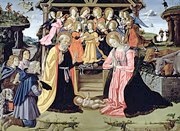
This altarpiece in the Galleria Nazionale was recorded in 1784 in Santa Maria di Monteluce, above the grill in the nuns' choir through which they took Communion. It was then attributed to Fiorenzo di Lorenzo but more recently has been linked to the payments that the nuns made to Bartolomeo Caporali in 1476-9.
-
✴The main panel (illustrated above) depicts the three kings (and their bedraggled dog) paying homage to the baby Jesus, who lies naked on the ground between His parents. Musical angels fill the stable behind, while the evicted animals look on. The scene is set in a rocky landscape, and the angels bring the news to shepherds on outcrops to the right and left.
-
✴The predella depicts the following saints in small tondi: SS Michael, Bernardino of Siena, Louis of Toulouse, Clare, Antony of Padua (who holds his tongue, which was found to be uncorrupted when his relics were translated in 1263) and Jerome.
The panels reached the gallery by different routes:
-
✴Dominique-Vivant Denon, the Director of the Musée Napoleon (later the Musée du Louvre) selected the main panel for confiscation after the Napoleonic suppression if 1810, and it was duly shipped to Paris. Antonio Canova recovered it in 1815 and it was returned to the church two years later. The nuns then managed to hold on to it until 1870, when it entered the gallery.
-
✴The predella, which escaped removal to France, was moved to the Accademia di Belle Arti in ca. 1839 and entered the gallery in 1863.
The gallery notes draw attention to the painting of silk used in the belts of St Joseph and the Virgin, and around the pomegranate on the step below the kneeling angel.
Crucifixion (late 15th century)
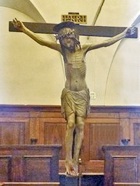
Monteluce Altarpiece (1505-25)
Contract of 1505
The “Memoriale di Santa Maria di Monteluce” records that the nuns decided to commission a new altarpiece for the high altar of their outer (public) church in 1503. They asked the friars at the Convento di Monteripido to recommend “il maestro il migliore” (the finest master) from whom they might commission it, and the friars recommended Raphael. The nuns therefore signed a contract in 1505 with Raphael and Berto di Giovanni. They paid a deposit using a bequest from Sister Illuminata de Perinello, and Raphael promised to deliver the work within two years.
The contract had a number of interesting features:
-
✴It specified that the altarpiece would match in quality or surpass that of the Coronation of the Virgin that Domenico Ghirlandaio had painted in 1486 for the high altar of the church of the Observant Franciscans of San Girolamo, Narni. Specifically, it would match the Narni altarpiece in terms of “perfection, proportions, quality, and condition ... [as well as in] the number of colours and figures”. It is interesting to note that the Observant Franciscans of Santa Maria della Pietà, la Fratta (now Umbertide) had made the same stipulation in respect of Pintoricchio’s altarpiece (1502-5) for the high altar of their church, and that Raphael seems to have been associated with its design.
-
✴It referred to Raphael as “Maestro”, and specified that he would personally paint the figures.
-
✴It provided for the cost of transport of the main panel to Perugia, so it was clearly intended that Raphael would paint it somewhere else: the terms of the contract applied in Perugia, Assisi, Gubbio, Rome, Siena, Florence Urbino and Venice. It seems that Berto’s role would relate to:
-
•the co-ordination of the project as a whole; and
-
•the painting of the subsidiary panels in Perugia.
Contract of 1516
No subsequent documents referring to this commission survive until 1516, when the nuns sent Berto di Giovanni to Rome, presumably to press Raphael to begin work, and the contract was duly renegotiated. It was witnessed by Alfano di Diamante, the nephew of Sister Battista and probably the commissioner of Raphael’s so-called Connestabile Madonna, and now specified only a year before delivery. This contract made a specific division between the work expected of the two artists:
-
✴Raphael would paint the main panel in Rome; and
-
✴Berto would paint, in Perugia, the frame and three predella panels, which would depict:
-
•the birth of the Virgin;
-
•the marriage of the Virgin; and
-
•the death of the Virgin.
This contract referred to a design by Raphael that had clearly been sent to the nuns in preparation for the contract negotiations. This suggests that the nuns had agreed to move away from the Narni altarpiece as a strict basis for the composition. The design that they accepted has been unfortunately been lost. It has been suggested that a drawing of the Dormition and Coronation of the Virgin in the British Museum, which is attributed to Giovanni Francesco Penni (see below), could be a copy of it. However, it seems odd that the nuns would have accepted this design while still requiring a scene of the death of the Virgin in the predella. In fact, the lower part of the drawing relates quite closely to the scene that was finally painted in the predella, albeit that it is reversed.
Berto di Giovanni provided a carpenter in 1518 to make the frame of the altarpiece and a "cassa” (probably a cover that protected it when it was not in use). However, the altarpiece had yet to be started when Raphael died in 1520.
Contract of 1523
In 1523, the nuns agreed a new contract for the main panel with two of Raphael’s associates in Rome: Giulio Romano and Giovanni Francesco Penni. Mariano di Ser Austerio acted on behalf of these artists in relation to payments made under this contract. Finally, on 25th June 1525, the “Memoriale di Santa Maria di Monteluce” records that “the Madonna, our finished painting, was delivered from Rome!”
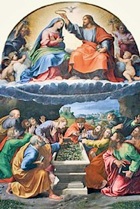
-
✴the upper panel, which depicts the Coronation of the Virgin, is attributed to Giulio Romano; and
-
✴the lower part, which depicts the Apostles gathered around the Virgin’s empty tomb, is attributed to Giovanni Francesco Penni.
John Shearman (referenced below) has produced a hypothesis that would account for the composite nature of the finished work, suggesting that:
-
✴Agostino Chigi had commissioned an altarpiece of the Assumption of the Virgin for his family chapel in Santa Maria del Popolo, Rome;
-
✴Giovanni Francesco Penni executed the commission after Raphael’s death but Chigi refused to accept it; and
-
✴its lower part was reused for the panel sent to Perugia.
The lower part of the composition makes narrative sense in the context of the subjects painted in the predella, since it follows from the scene of the death of the Virgin. It is clearly not based on the lower part of the Narni altarpiece, but it is close to the lower part of Raphael’s Oddi Altarpiece. This suggests that the main panel did indeed follow a now-lost design by Raphael.
The frame for the altarpiece had been delivered to Berto di Giovanni for painting in 1524. He presumably began the three predella panels at this time. He also agreed to add a fourth predella panel, depicting the Presentation of the Virgin, as well of panels of SS Francis and Clare for the pilasters of the frame. This work was presumably completed in 1525, the date inscribed on predella panel of the birth of the Virgin. The finished altarpiece was probably in place on the high altar of Santa Maria di Monteluce in time for the Feast of the Assumption.
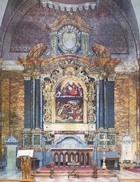




The surviving panels were never reunited:
-
✴The main panel was one of three works of art in Perugia that were earmarked by the French for confiscation under the Treaty of Tolentino (1797). It was the subject of an important restoration in Paris in 1801. Antonio Canova recovered it in 1815, when it was secured for the Pinacoteca Vaticana. In return, Pope Leo XII gave the nuns a sum of money and the copy of the panel that can still be seen in the apse of the church.
-
✴The other panels were taken to Rome in 1812. Two of them (those depicting SS Francis and Clare were subsequently lost. The four predella panels were returned to the church in 1817 and moved to the Galleria Nazionale in 1863.
Santa Maria di Monteluce: Main page Church Nuns’ choir Art from church.
Return to Nunneries of Perugia.
Return to Monuments of Perugia.

